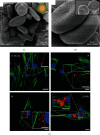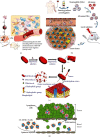Design and Optimization of the Circulatory Cell-Driven Drug Delivery Platform
- PMID: 34603454
- PMCID: PMC8481068
- DOI: 10.1155/2021/8502021
Design and Optimization of the Circulatory Cell-Driven Drug Delivery Platform
Abstract
Achievement of high targeting efficiency for a drug delivery system remains a challenge of tumor diagnoses and nonsurgery therapies. Although nanoparticle-based drug delivery systems have made great progress in extending circulation time, improving durability, and controlling drug release, the targeting efficiency remains low. And the development is limited to reducing side effects since overall survival rates are mostly unchanged. Therefore, great efforts have been made to explore cell-driven drug delivery systems in the tumor area. Cells, particularly those in the blood circulatory system, meet most of the demands that the nanoparticle-based delivery systems do not. These cells possess extended circulation times and innate chemomigration ability and can activate an immune response that exerts therapeutic effects. However, new challenges have emerged, such as payloads, cell function change, cargo leakage, and in situ release. Generally, employing cells from the blood circulatory system as cargo carriers has achieved great benefits and paved the way for tumor diagnosis and therapy. This review specifically covers (a) the properties of red blood cells, monocytes, macrophages, neutrophils, natural killer cells, T lymphocytes, and mesenchymal stem cells; (b) the loading strategies to balance cargo amounts and cell function balance; (c) the cascade strategies to improve cell-driven targeting delivery efficiency; and (d) the features and applications of cell membranes, artificial cells, and extracellular vesicles in cancer treatment.
Copyright © 2021 Pengyu Gao et al.
Conflict of interest statement
The authors declare no conflict of interest, financial or otherwise.
Figures





References
-
- World Health Organization. WHO - the top 10 causes of death. May 2018, http://www.who.int/en/news-room/fact-sheets/detail/the-top-10-causes-of-....
-
- Jing L., Hao H., Peng M., Yuanquan W. Current status and prospect of cancer nanomedicine in clinical translation. Science & Technology Review . 2018;36(22):118–126.
Publication types
LinkOut - more resources
Full Text Sources

